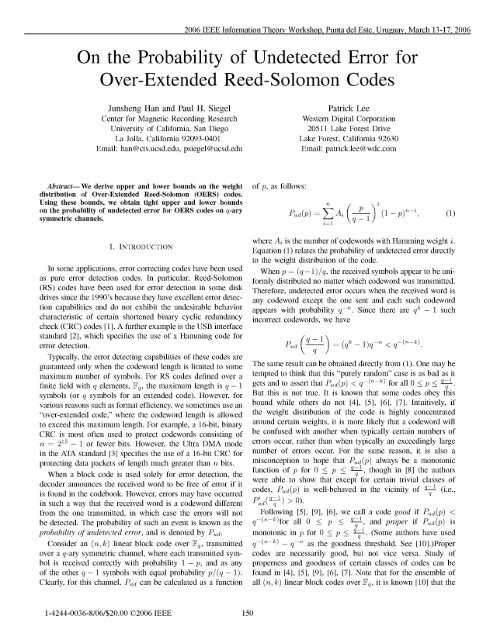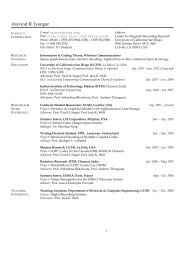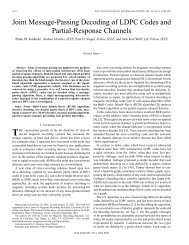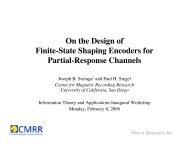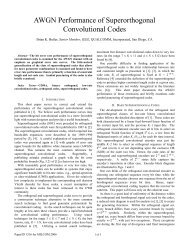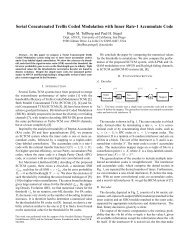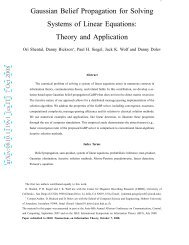On the Probability of Undetected Error for Over ... - IEEE Xplore
On the Probability of Undetected Error for Over ... - IEEE Xplore
On the Probability of Undetected Error for Over ... - IEEE Xplore
Create successful ePaper yourself
Turn your PDF publications into a flip-book with our unique Google optimized e-Paper software.
2006 <strong>IEEE</strong> In<strong>for</strong>mation Theory Workshop, Punta del Este, Uruguay, March 13-17, 2006<br />
<strong>On</strong> <strong>the</strong> <strong>Probability</strong> <strong>of</strong> <strong>Undetected</strong> <strong>Error</strong> <strong>for</strong><br />
<strong>Over</strong>-Extended Reed-Solomon Codes<br />
Junsheng Han and Paul H. Siegel<br />
Patrick Lee<br />
Center <strong>for</strong> Magnetic Recording Research<br />
Western Digital Corporation<br />
University <strong>of</strong> Cali<strong>for</strong>nia, San Diego<br />
20511 Lake Forest Drive<br />
La Jolla, Cali<strong>for</strong>nia 92093-0401 Lake Forest, Cali<strong>for</strong>nia 92630<br />
Email: han@cts.ucsd.edu, psiegel@ucsd.edu<br />
Email: patrick.lee@wdc.com<br />
Abstract-We derive upper and lower bounds on <strong>the</strong> weight<br />
<strong>of</strong> p, as follows:<br />
distribution <strong>of</strong> <strong>Over</strong>-Extended Reed-Solomon (OERS) codes.<br />
Using <strong>the</strong>se bounds, we obtain tight upper and lower bounds n<br />
on <strong>the</strong> probability <strong>of</strong> undetected error <strong>for</strong> OERS codes on q-ary Pud (P) Ai P (1 _ p)n-i (1)<br />
symmetric channels. q -1<br />
where Ai is <strong>the</strong> number <strong>of</strong> codewords with Hamming weight i.<br />
I. INTRODUCTION Equation (1) relates <strong>the</strong> probability <strong>of</strong> undetected error directly<br />
to <strong>the</strong> weight distribution <strong>of</strong> <strong>the</strong> code.<br />
<strong>the</strong> received symbols appear to be uni-<br />
In some applications, error correcting codes have been used When p = (q -1) lq,<br />
as pure error detection codes. In particular, Reed-Solomon <strong>for</strong>mly distributed no matter which codeword was transmitted.<br />
(RS) codes have been used <strong>for</strong> error detection in some disk There<strong>for</strong>e, undetected error occurs when <strong>the</strong> received word is<br />
drives since <strong>the</strong> 1990's because <strong>the</strong>y have excellent error detec- any codeword except <strong>the</strong> one sent and each such codeword<br />
tion capabilities and do not exhibit <strong>the</strong> undesirable behavior appears with probability q-n. Since <strong>the</strong>re are qk -1 such<br />
characteristic <strong>of</strong> certain shortened binary cyclic redundancy incorrect codewords, we have<br />
check (CRC) codes [1]. A fur<strong>the</strong>r example is <strong>the</strong> USB interface<br />
standard [2], which specifies <strong>the</strong> use <strong>of</strong> a Hamming code <strong>for</strong> p q- k 1-(-k)<br />
error detection. Pud (q - 1)q 0).<br />
from <strong>the</strong> one transmitted, in which case <strong>the</strong> errors will not Following [5], [9], [6], we call a code good if Pud(p) <<br />
be detected. The probability <strong>of</strong> such an event is known as <strong>the</strong> q-(nk)<strong>for</strong> all 0 < p < q-1 and proper if Pud(p) is<br />
probability <strong>of</strong> undetected error, and is denoted by Pud. monotonic in p <strong>for</strong> 0 < p < q-1 (Some authors have used<br />
q<br />
Consider an (ni,k) linear block code over F ,transmitted q-(nk) - qf as <strong>the</strong> goodness threshold. See [10].)Proper<br />
over a q-ary symmetric channel, where each transmitted sym- codes are necessarily good, but not vice versa. Study <strong>of</strong><br />
bol is received correctly with probability 1 -p, and as any properness and goodness <strong>of</strong> certain classes <strong>of</strong> codes can be<br />
<strong>of</strong> <strong>the</strong> o<strong>the</strong>r q -1 symbols with equal probability pj(q -1). found in [4], [5], [9], [6], [7]. Note that <strong>for</strong> <strong>the</strong> ensemble <strong>of</strong><br />
Clearly, <strong>for</strong> this channel, Pud can be calculated as a function all (ni, k) linear block codes over Fq, it is known [10] that <strong>the</strong><br />
1-4244-0036-8/06/$20.00 ©C2006 <strong>IEEE</strong> 150
average probability <strong>of</strong> undetected error is For very low weights, <strong>the</strong> problem <strong>of</strong> determining <strong>the</strong><br />
qk 1 corresponding term in <strong>the</strong> weight enumertor is tractable - we<br />
pav (P) (1n<br />
- (1 p)f) can fully characterize all codewords <strong>of</strong> a given low weight<br />
- 1and <strong>the</strong>reby count <strong>the</strong>m. The results <strong>for</strong> weight-2 and weight-<br />
For systematic codes, a similar result is known [11], [8]: 3 codewords are summarized in <strong>the</strong> following propositions.<br />
psYS(p) q (n-k)(1 (1- k) Proposition 1 The number <strong>of</strong> weight-2 codewords in an<br />
OERS code is<br />
Note that in ei<strong>the</strong>r case, <strong>the</strong> average per<strong>for</strong>mance <strong>of</strong> a ran- -() (q 1)2 + ab(q-1) if d > 2<br />
domly chosen code satisfies <strong>the</strong> conditions <strong>for</strong> both goodness<br />
2, d 2<br />
n<br />
A/ = ') (q- 1) ifd= ,<br />
and properness. 2 2<br />
In this paper, we consider <strong>Over</strong>-Extended Reed-Solomon (2) (q 1) if d 1<br />
(OERS) codes. From a practical point <strong>of</strong> view, <strong>the</strong>se codes where a and b are integers such that n' = an + b, 0 < b < n.<br />
are constructed by reusing a (shift register type) RS encoder<br />
but allowing a longer input. Let C be a RS code over Fq with Corollary 2 If d > 2 and n. n', <strong>the</strong>n A= (n) (q - 1)2. g<br />
length n. q -C1 and minimum distance d. Then C can be<br />
described as <strong>the</strong> set <strong>of</strong> polynomials c(e)such that<br />
For example, if <strong>the</strong> OERS code has twice <strong>the</strong> length <strong>of</strong> <strong>the</strong><br />
original RS code, <strong>the</strong>n A' = (q - 1)2 if d > 2.<br />
c(z) = -r(x) + x d-1<br />
(x) (') -r(x)+ u()(2)<br />
(2)<br />
Proposition 3 The number <strong>of</strong> weight-3 codewords in an<br />
where u(x) is <strong>the</strong> data polynomial <strong>of</strong> degree at most n - d, OERS code is<br />
and r(x) is <strong>the</strong> remainder <strong>of</strong> xd-lu(x) divided by g(x), <strong>the</strong> ((3) (q - 1) + (a)b) (q - 1)(q - 2) if d > 3<br />
generator polynomial <strong>of</strong> C. An OERS code C' can <strong>the</strong>n be J { ( -<br />
(n' -2) ((a) (q -1) + ab)<br />
defined simply by allowing u(x) in (2) to have degree higher A/ + q ((a) (q - 1) + (a)b) }(q - 1) if d = 3<br />
than n - d, such that <strong>the</strong> length <strong>of</strong> <strong>the</strong> code is extended to | 1 2 i d-2<br />
n' > n. This results in a linear (n' , n' -d + l) code over ]Fq,<br />
q q<br />
The rest <strong>of</strong> <strong>the</strong> paper is arranged as follows. In Section II, ( 3<br />
- f d 2<br />
we derive upper and lower bounds on <strong>the</strong> weight distribution <strong>of</strong> where a and b are integers such that n' = an + b, 0 < b < mm n.<br />
OERS codes. In Section III, we apply <strong>the</strong> results <strong>of</strong> Section II<br />
to obtain tooban bounds ond onn <strong>the</strong> hepobbliy<strong>of</strong>uneece.err.o probability <strong>of</strong> undetected error <strong>for</strong>prahtunesndgteetiewgtdsrbton The study <strong>of</strong> <strong>the</strong>se special cases motivates a general ap-<br />
OERS codes on q-ary symmetric channels. We <strong>the</strong>n prove that proach to understanding <strong>the</strong> entire weight distribution <strong>of</strong><br />
f<br />
.<br />
tERS bondes onqare tight.mInmSectrio IV,hann<br />
Wex pen iven<br />
t OERS codes. The following two lemmas, though simple, are<br />
<strong>the</strong>se bounds are tight. In Section IV, an example iS givenl th'ai o uho h dsusohtflos<br />
to demonstrate <strong>the</strong> effectiveness <strong>of</strong> <strong>the</strong> bounds. Section V<br />
concludes <strong>the</strong> paper. Lemma 4 If c(x) C Fq[x] and deg(c) < n', <strong>the</strong>n c(x) C C' if<br />
II.<br />
WEIGHT DISTRIBUTION<br />
f<br />
and only if Rxrl_1[c(x)] C C. :<br />
First, a few remarks on notation. Throughout <strong>the</strong> rest <strong>of</strong> Lemma 5 For all c(x) Fq[3],<br />
<strong>the</strong> paper, unless o<strong>the</strong>rwise stated, C is a RS code over Fq wt(c(x)) > wt(RXn_ [c(X)]).<br />
with length n = q - 1, minimum distance d, and generator<br />
polynomial g(x); C' is <strong>the</strong> OERS code constructed from C Let Az denote <strong>the</strong> set <strong>of</strong> weight-i codewords <strong>of</strong> C' We are<br />
. , . . - . . , ~~~~~~~interested in finding A =A'a <strong>for</strong> all 1. From Lemma 4,<br />
with length n' > n. In most <strong>of</strong> our discussions, C and C' t<br />
will be interpreted as subsets <strong>of</strong> Fq[X], <strong>the</strong> set <strong>of</strong> polynomials since 0 e C, if we define 13 = {c(x) C Fq[3] t(C(X))<br />
with coefficients in Fq. If c(x) C Fq[X], <strong>the</strong>n deg(c(x)) is ,deg(c(x)) n.. There<strong>for</strong>e, all OERS codes contain codewords <strong>of</strong> tP~(i(n,r) := {6 C tPi: 16
The <strong>for</strong>mula <strong>for</strong> B' can now be stated, as follows.<br />
Proposition 7 For all i, 35<br />
(3 3 .5<br />
11<br />
where '{l.j} =1 if 1 < j, 0 o<strong>the</strong>rwise, a [= 2 ,bnj/, b-<br />
Rn[~n'] and 1. = ,3<br />
It can be shown thlat A4 13$ <strong>for</strong> i d.<br />
Fig. 1. Breakdown <strong>of</strong> Pud (p) by weights <strong>for</strong> a (15, 13) RS code over F16.<br />
Proposition 9 This code is good.<br />
AX J (n)q id±l±+B/ if d. Fr,/n2(d-2). 4<br />
(4) 3.5 Pud(P)<br />
wrpoitha iojn. j b<br />
i- l(t')(q-d)(q- i)i d [r'/r]d (5f<br />
>5\i1 1), t<br />
where l
can add up <strong>the</strong> corresponding fi (p)'s to get a lower bound. where<br />
In particular, consider contribution from weight-2 codewords<br />
alone. We already know how many weight-2 codewords <strong>the</strong>re p Ed<br />
are, so <strong>the</strong> following result is immediate. _ud (P) SBi q 1( P)<br />
Proposition 11 For d > 2, a simple lower bound on Pud(p) ( [](d- 1)<br />
IS Pv,d(p) > E<br />
p1ud(p), + (1)d -<br />
(i> i- P)n-i)<br />
where<br />
1n'] (d-1)<br />
Puj)(p) a(() + b p2(1 p)n'-2 + ( )d K5 p (1-p)<br />
and a and b are integers such that n' = a(q - 1) + b, 0 < b <<br />
q -1. F- nnti] (d-2)i<br />
Note that from (1), it is clear that as p -* 0, Pud(p) is dom- Pud(p) = B (q 1p<br />
inated by <strong>the</strong> contribution from mininum weight codewords. / d-1<br />
There<strong>for</strong>e, <strong>the</strong> bound ud (p) is asymptotically tight as p -*0. + 1 1 i(1 -)n'i<br />
In fact, we shall see later that, under some mild conditions, (q - l)d1 Vi jP P11<br />
this bound is also tight <strong>for</strong> bounding <strong>the</strong> worst-case Pud.<br />
nThe dP tohow that mOES codes<br />
codes are not good. The message here is that OERS codes<br />
We now use <strong>the</strong> bound p)(2) to show that most OERS where B' is given by (3), and Ki' by (6).<br />
Corollary 14 For OERS codes,<br />
<strong>the</strong> worst-case probability <strong>of</strong><br />
tend to have a disproportionately large number <strong>of</strong> weight-2 undetected error, max maxo 1 be fixed. If d > 3, <strong>the</strong>n OERS<br />
codes are not good when q is sufficiently large. 2 Proposition 16 For any given n'/n and d> 3, as q oo,<br />
-max<br />
The approximate analysis above also shows us that <strong>the</strong> p(2) prmax pnmax pd<br />
degree <strong>of</strong> per<strong>for</strong>mance degradation from <strong>the</strong> good-code bound,<br />
i.e. Cq-2 versus q- (d1), is most sensitive to d. The crucial Finally, we should note that since RS codes are usually<br />
matter here is that <strong>the</strong> number <strong>of</strong> weight-2 codewords in an used <strong>for</strong> relatively short block lengths, <strong>the</strong> asymptotic analysis<br />
OERS code does not depend on <strong>the</strong> number <strong>of</strong> parity check may seem less useful. However, it is clear that as long as<br />
symbols (in this case d - 1). While Padg is expected to n' >[>[ n(d -1), i.e. n >> d -1, <strong>the</strong> asympotic behavior<br />
decrease exponentially with d, P(2) is not affected. The gap is well approximated and is instructive <strong>for</strong> predicting how tight<br />
in per<strong>for</strong>mance can be very pronounced even when d is only <strong>the</strong>se bounds are. Since <strong>for</strong> storage systems, high rate codes<br />
moderately larger than 3. are common, this condition is in many cases valid.<br />
We now give upper and lower bounds on Pud (p) <strong>for</strong> OERS The asymptotic results can also be used to reduce complexcodes,<br />
based on bounds we have obtained on <strong>the</strong>ir weight ity <strong>of</strong> <strong>the</strong> bounds. In particular, in <strong>the</strong> lower bound (5) onA'<br />
distribution. it can be seen that B' is negligibly small and can be safely<br />
Thus, in <strong>the</strong> expression <strong>of</strong> ud (p), we only need to<br />
. . ~~~~~~~~~~~~ignored.<br />
Proposition 13 For QERS codes, calculate B"'s up to i =d -1. (We could do <strong>the</strong> same <strong>for</strong> <strong>the</strong><br />
EPd(P) . Pud(p) . Pud(p), upper bound but it would make it an approximate bound.)<br />
153
~~~~~~~~~~~~~~REFERENCES<br />
TABLE I<br />
10 ......................................BOUNDS ON pmdax FOR (2m+1 2, 2m+1 5) OERS CODES OVER 1F2<br />
L Lower:bound--: b_un X -:- -:-: K......... :: -: ... ......... ... :--: nmax pmax -max (2)<br />
ud ud ud ax<br />
m 3 3.5 120e-03 3.3622e-03 3.7427e-03 3.2095e-03<br />
- -- m 5 1.5004e-04 1.4946e-04 1.5054e-04 1.4550e-04<br />
10<br />
,.. .. ._ .. .. ..<br />
m-6 3.24e0 3X10-5 35325 344e0<br />
8.5262e-06 8.5241e-06 8.5279e-06 8.4573e-06<br />
-6 - -----------------------------<br />
-m8- 2.0979e-06 2.0981e-06 2.0895e-06<br />
10 ._.<br />
1 J. K. . . B...... .,k , , " l <strong>of</strong><br />
.M. ...., Oct.<br />
_- ._. !!..<br />
q^-7 .....<br />
..n :... T.h.: .....<br />
1 -8 I<br />
11]° °-V1<br />
01<br />
CAS STU [ l] J. K. Wolf and R. D. Blakeney,<br />
WecloseourdiscssionbapplyinourreultsobaiMILCOM ..~~~~~~~~~~~~~~~~~p. 23-3, 88, Ma. Oct. 17.. 1988, pp. 287-292.<br />
[2] "Universal Senal Bus specification," Revision 2, Apr. 2000.<br />
GERcodes_over [4 5. K_. Ḷn ad M. E_. Hm "C.on. ..a b<br />
p0 10 10 1p<strong>of</strong> undetected error <strong>for</strong> certain shortened binary CRC codes," in Proc.<br />
E. , "An exact evaluation <strong>of</strong> <strong>the</strong> probability<br />
Fig. 3. Upper and lower bounds on Pud(p) <strong>for</strong> (2m+ 2,2m+l - -5) [3] "ATA 6 specification," Document Number T13/1410D, Revision 3B.<br />
OERS codes over iF2. [4] S. K. Leung-Yan-Cheong and M. E. Hellman, "Conceming a bound on<br />
undetected error probability," <strong>IEEE</strong> Trans. In<strong>for</strong>m. Theory, vol. IT-22,<br />
pp. 235-237, Mar. 1976.<br />
IV. CASE STUDY [5] S. K. Leung-Yan-Cheong, E. R. Bames, and D. U. Friedman, "<strong>On</strong> some<br />
<strong>for</strong> m 3, 4, 5, 6. These have been obtained from equatiproperties <strong>of</strong> <strong>the</strong> undetected error probability <strong>of</strong> linear codes," <strong>IEEE</strong><br />
We close our discussion by applying our results obtained so Trans. In<strong>for</strong>m. Theory, vol. IT-25, pp. 110-112, Jan. 1979.<br />
(1),to an example class <strong>of</strong> OERS codes. [6] T. Kasami and S. Lin"O<strong>the</strong> n probability <strong>of</strong> undetectederror <strong>for</strong><strong>the</strong><br />
* ~~~~~~~maximum distance separable codes," <strong>IEEE</strong> Trans. Commun., vol. COM-<br />
Consider an RS code with d = 4 over iF2i extended to dou- 32, pp. 998-1006, Sept. 1984.<br />
ble its length, i.e. n' = 2n = 2(2M- 1) = 2'+1 2. Figure 3 [7] T. Fujiwara, T. Kasami, A. Kitai, and S. Lin, "<strong>On</strong> <strong>the</strong> undetected error<br />
chode foloed by a applicatio <strong>of</strong>o<strong>the</strong> M probability <strong>for</strong> shortened Hamming codes," <strong>IEEE</strong> Trans. Commun., vol.<br />
[13]s[14]. It s<br />
cWilaspidn Kluwud (p) esCOM-33, pp. 570-574, June 1985.<br />
to different values <strong>of</strong> m. Also shown arte ua Pud (p) curves [8] J. K. Wolf, A. M. Michelson, and A. H. Levesque, "<strong>On</strong> <strong>the</strong> probability<br />
<strong>for</strong> 3e4n5n m =<br />
6. These have been obtained from equation <strong>of</strong> undetected error <strong>for</strong> linearblock codes," <strong>IEEE</strong> Trans. Commun., vol.<br />
(1) where <strong>the</strong> weight distribution <strong>of</strong> C' is calculated by a COM-30, pp. 317-324, Feb. 1982.<br />
' [9] T. Kasami, KLa T. ve, and S. Lin, "Linear block codes <strong>for</strong> error detection,"<br />
brute-<strong>for</strong>ce evaluation <strong>of</strong> <strong>the</strong> weight distribution <strong>of</strong> its dual <strong>IEEE</strong> Trans. In<strong>for</strong>m. Theory, vol. IT-29, pp. 131-136, Jan. 1983.<br />
code followed by an application <strong>of</strong> <strong>the</strong> MacWilliams identity [10] T. KCaveand V. J.Korzhik, <strong>Error</strong> Detecting Codes: General Theory and<br />
both bounds are<br />
sal3] (p4]. Itenholds shouldoinated tenotedthat <strong>the</strong> asymptot byat this(p)tasfprce Moretopouroitedrest, 0.rAse gets iTheir 47Kluwer, Application 1995.<br />
in Feedback Communication Systems. Boston, MA:<br />
<strong>On</strong>ly possible when d is small (so that <strong>the</strong> dual code is <strong>of</strong> low [11] J. Massey, "Coding techniques <strong>for</strong> digital networks," in Proc. Interdimension).<br />
In our case, <strong>for</strong> m > 7, <strong>the</strong> enumeration becomes<br />
national Conference on In<strong>for</strong>mation Theory Systems, Berlin, Gearany,<br />
noteawherlongmp8,pess; <strong>for</strong> <strong>the</strong>s (510on, 507) codeis) bounded<strong>for</strong> 12] R L Graham, D. E. Knuth, and O. Patashnik, Concrete Ma<strong>the</strong>matics,<br />
Tm = 8 have not been given. 2nd ed. Reading, MA: Addison-Wesley, 1994, ch. 9.<br />
We see that <strong>for</strong> all m, our upper and lower bounds become d[13]<br />
J. M. Williams, "A <strong>the</strong>orem on <strong>the</strong> distdbution <strong>of</strong> weights in a<br />
ver tih o ml hne ro ae Ṫhi is exece sic systematic code," Bell Syst. Tech. J., vol. 42, pp. 79-94, Jan. 1963.<br />
wdd e14] S.-C. Chang and J. K. Wolf, "A srmple deivaton <strong>of</strong> <strong>the</strong> MacWilliams<br />
both bounds are dominated by Pt d (p) as p > 0. As p gets identity <strong>for</strong> linear codes," <strong>IEEE</strong> Trans. In<strong>for</strong>m. Theory, vol. IT-26, pp.<br />
small, Pud(p) tendshaveb shonto be aseyM pto our interest, 476-477, July 1980.<br />
wTee that d as m increases, <strong>the</strong> bounds quickly get tight at<br />
all values <strong>of</strong> p, and <strong>the</strong>y do so even quicker at <strong>the</strong> worst-case<br />
Pud. The numerical values <strong>of</strong> bounds on pmdax are shown<br />
<strong>the</strong>iry<br />
in Table pert<strong>for</strong>smance I. As an ihnnterm example er<strong>of</strong>proabilit how tight <strong>of</strong><strong>the</strong>se undetpected bounds<br />
sner'ror.'.<br />
are,<br />
note when m = 8, Pmax <strong>for</strong> <strong>the</strong> (510, 507) code is bounded<br />
between 2.0979 x 10-6 and 2.0981 x 10-6.<br />
V. CONCLUSION<br />
OERS codes are <strong>of</strong> practical interest as <strong>the</strong>y have been<br />
used in data storage systems. In this work we have examined<br />
<strong>the</strong>ir per<strong>for</strong>mance in terms <strong>of</strong> probability <strong>of</strong> undetected error


